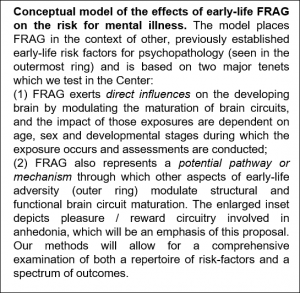Overall Center
The Conte Center @ UCI focuses on the contribution of early-life experiences, especially of unpredictable and fragmented maternal and environmental signals, to adolescent vulnerabilities and adult mental illness. It aims to advance the understanding of the underlying mechanisms involving disruption of the maturation of cognitive and emotional brain circuits.
Complex behaviors involve coordinated activities of brain circuits that integrate molecular, cellular, synaptic and network signaling. Hence, mental disorders may arise from dysfunction of specific brain circuits. Such failure originates from genetic risk and environmental influences, particularly during sensitive developmental periods. Environment-derived sensory signals clearly influence development of brain circuits (visual, auditory) and may drive aberrant circuit maturation that can promote emotional and cognitive problems, yet there are critical knowledge gaps of the nature of the signals that contribute to vulnerabilities to mental illness, and how they disrupt brain circuit maturation. Acquiring such knowledge of complex behaviors and their disruption in mental illness, a research priority of NIMH, demands trans-disciplinary approaches across species and development, and integration of multiple levels of analyses through powerful computational modeling tools.
Among environmental influences, early-life adversity is an established risk factor for human mental illness. Contributors to early-life adversity such as maternal depression and low socio-economic status explain a significant portion of mental problems later in life, yet there are serious gaps in our ability to identify early vulnerability to mental illness - a prerequisite for intervention and an NIMH research priority. Here, we posit that unpredictable, fragmented sensory signals (FRAG) from the mother and environment constitute a previously unrecognized indicator of early-life adversity. This hypothesis originated from mechanistic animal studies where consistent, predictable patterns of maternal-derived signals promote resilience by modulating excitatory synapse innervation (and hence circuit maturation), inducing enduring changes in epigenetic programs of specific cell populations. By contrast, FRAG promotes aberrant maturation of brain circuits involved in emotion and cognition, with commensurate behavioral deficits. We (1-4) and others (5) now find that FRAG influences mental health outcomes via modulation of brain circuit maturation in humans, with profound translational impact. Our experimental animal systems enable probing od mechaisms at molecular and circuit levels.



We continue to focus on cognitive and emotional (anxiety, depression) vulnerabilities. We have also identified anhedonia as a robust direct consequence of early-life FRAG in experimental systems, associated with evidence of aberrant pleasure / reward circuit maturation. Anhedonia, a dimensional (RDoC) entity linked to multiple mental disorders, is a recently-identified core feature of PTSD. We emphasize anhedonia because it follows FRAG in children (Project 2), adolescents (Project 3) and young adults (Project 4) and predicts risk for post-combat mental illness in a vulnerable population of Marines (Project 4).
In the coming years we aim to:
1) Test the relative contribution of FRAG, along with other early-life risk factors, to mental health outcomes including anhedonia, emphasizing sex effects and using tools enabling practical assessments across diverse ages and cohorts.
2) Test the mechanisms underlying the effects of FRAG on the developing brain, with sensitivity to age- and sex-specific vulnerabilities and developmentally appropriate assessment tools. Integrating multiple levels of analysis, we will employ imaging and computational models focusing on brain circuit disruption; we will employ molecular and viral-genetic tools and capitalize on experimental animal systems to identify the underlying neurobiological mechanisms.
3) Create behavioral and neuroimaging sex-specific developmental trajectories from infancy to adulthood using our three, prospective, well-characterized cohorts and repeated intra-individual measurements. We will generate predictive models for risk of anhedonia and vulnerability to mental illness. Capitalizing on experimental animal data, we will generate intra-individual epigenetic signatures of FRAG in children as potential biomarkers.
4) Serve as a training forum and a magnet for the study and improved understanding of how early life experiences influence emotional and cognitive outcomes. Locally, the Center will augment its existing training activities, seminars, symposia and seed grants. Nationally and internationally, the Center will enhance the impact and generalizability of our discoveries through resource sharing and will reach out to teams studying at-risk populations.
In summary our collaborative, cross species and multidisciplinary Conte Center identifies FRAG as a novel source of aberrant brain circuit development that portends vulnerability to mental illness; it integrates FRAG within existing frameworks and offers novel, age-and sex-specific predictive markers of vulnerability to mental illness, and hence experiment-based, transformative paths for preventative interventions.

